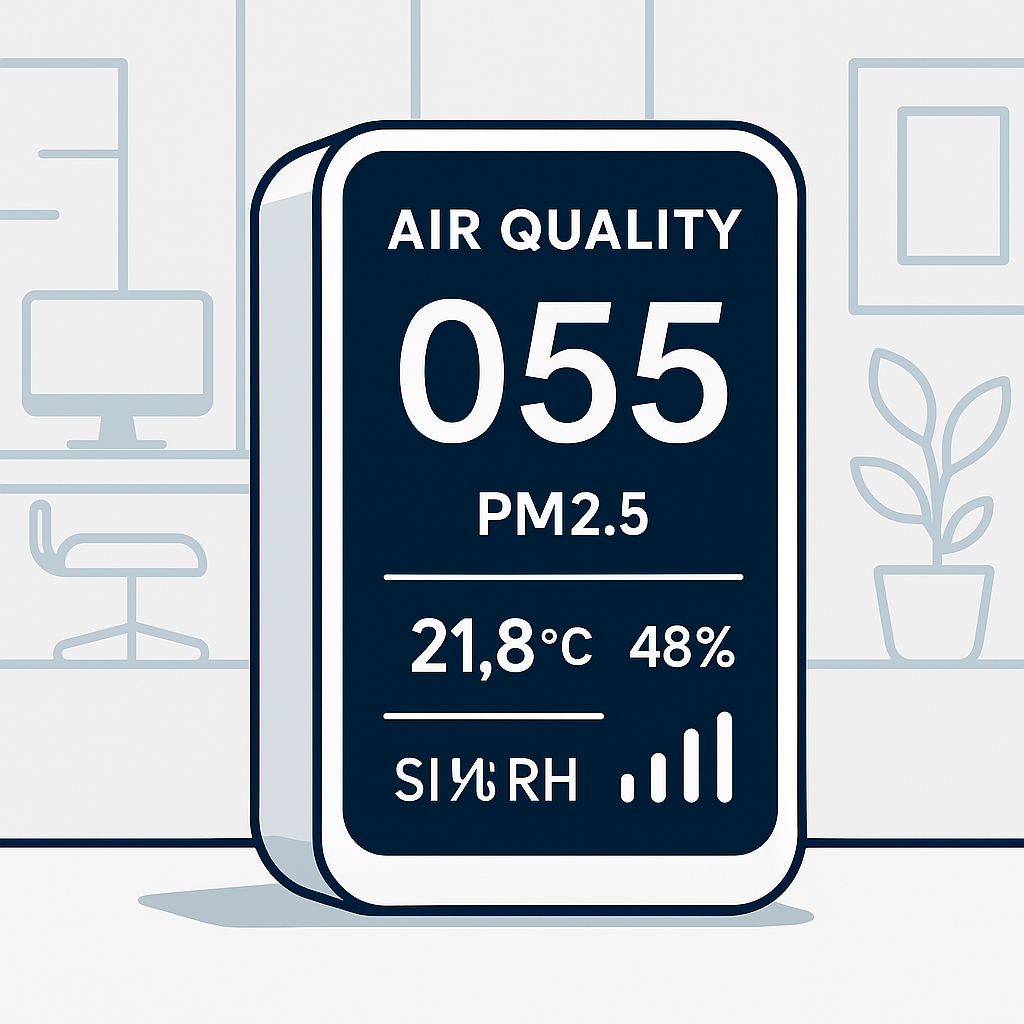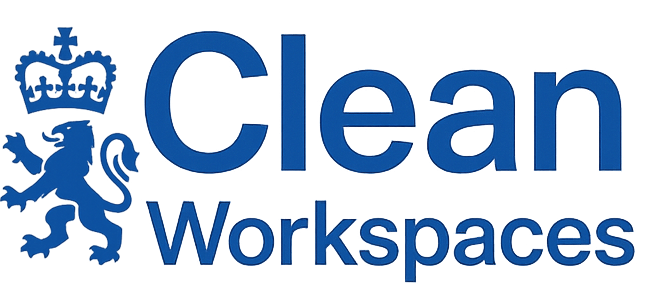Air Quality Monitoring in Commercial Buildings
Advanced approaches to measuring, assessing, and optimizing indoor air for workplace health

Indoor air quality has emerged as a critical component of workplace health and productivity. With employees spending approximately 90% of their working hours indoors, the quality of the air they breathe significantly impacts cognitive function, respiratory health, and overall wellbeing. This article explores the latest approaches to monitoring, assessing, and improving indoor air quality in commercial environments.
The Business Case for Air Quality Management
The impact of poor indoor air quality extends far beyond simple comfort concerns:
- Cognitive performance: Research shows that elevated CO2 levels and volatile organic compounds (VOCs) can reduce cognitive function by up to 50% in areas like strategic thinking and information processing
- Absenteeism: Poor air quality contributes significantly to respiratory illness, allergies, and other health issues that increase sick days
- Employee satisfaction: Air quality consistently ranks among the top environmental factors affecting workplace satisfaction
- Productivity losses: Conservative estimates suggest poor indoor air quality costs UK businesses £15 billion annually in reduced productivity
- Legal and regulatory considerations: Employers have legal obligations regarding workplace air quality under Health and Safety regulations
According to our ventilation and reduced sick days research, organizations implementing comprehensive air quality monitoring and management programs typically see a 23-30% reduction in respiratory-related absenteeism and an 11-15% improvement in self-reported productivity measures.
Key Indoor Air Quality Parameters
Comprehensive air quality assessment requires monitoring several distinct parameters:
Carbon Dioxide (CO2)
A key indicator of ventilation adequacy and occupant density. Elevated levels indicate insufficient fresh air exchange.
Target Levels:
- • Ideal: 400-800 ppm
- • Acceptable: 800-1000 ppm
- • Concerning: >1000 ppm
- • Cognitive impact begins: ~1000 ppm
Particulate Matter (PM2.5 & PM10)
Microscopic particles that can penetrate deep into the lungs. Sources include outdoor pollution, HVAC systems, and office activities.
Target Levels:
- • PM2.5 Ideal: <10 μg/m³
- • PM2.5 Acceptable: <12 μg/m³
- • PM10 Ideal: <20 μg/m³
- • PM10 Acceptable: <25 μg/m³
Volatile Organic Compounds (VOCs)
Gases emitted from products, materials, and building components. Common sources include furniture, cleaning products, and office equipment.
Target Levels:
- • Total VOCs Ideal: <0.3 mg/m³
- • Total VOCs Acceptable: <0.5 mg/m³
- • Formaldehyde: <0.1 mg/m³
Temperature & Relative Humidity
Key comfort factors that also influence contaminant behavior and microbial growth potential.
Target Levels:
- • Temperature (Winter): 20-23°C
- • Temperature (Summer): 23-26°C
- • Relative Humidity Ideal: 40-60%
- • Humidity Range: 30-70%
Additional parameters may be relevant in specific environments, including carbon monoxide, ozone, nitrogen dioxide, radon, and specific microbial contaminants. A thorough initial assessment should determine which parameters are most relevant for ongoing monitoring in your particular facility.
Organizations using eco-friendly cleaning supplies may find significantly lower VOC levels compared to those using conventional cleaning chemicals, highlighting the interconnection between cleaning practices and air quality.
Modern Air Quality Monitoring Technologies
Significant advances in sensor technology have transformed air quality monitoring from periodic professional assessments to continuous, real-time measurement systems:
Fixed Monitoring Systems
Permanent installations providing continuous monitoring of key parameters:
- Building-integrated sensors: Devices integrated with building management systems
- Zone-specific monitors: Distributed sensors providing localized readings for different areas
- HVAC-integrated sensors: Monitors directly connected to ventilation systems for automated response
- Network-connected platforms: Systems providing centralized data collection and analysis
These systems typically provide continuous monitoring with automated alerts when parameters exceed established thresholds. More advanced systems can be integrated with building automation to trigger increased ventilation or air purification when needed.
Sensor Placement Considerations
Fixed sensors should be positioned at breathing height (1.1-1.7m from floor) in representative locations that avoid direct air streams from HVAC outlets, direct sunlight, or proximity to localized sources (printers, kitchen equipment, etc.) that could skew readings.
Portable Assessment Tools
Mobile equipment for detailed investigations and spot-checking:
- Professional-grade analyzers: High-accuracy instruments for detailed assessments
- Handheld multi-parameter devices: Portable tools measuring multiple contaminants
- Indoor air quality kits: Comprehensive testing packages for periodic evaluation
- Specialized leak detectors: Equipment for identifying specific emission sources
These tools are particularly valuable for troubleshooting specific air quality complaints, verifying fixed sensor accuracy, and conducting detailed investigations of problem areas. They complement rather than replace continuous monitoring systems.
Advanced Data Analytics
Modern air quality monitoring extends beyond simple measurement to sophisticated data analysis:
- Pattern recognition: Identifying trends and correlations between parameters
- Predictive analytics: Anticipating air quality issues before they become problematic
- Occupancy correlation: Analyzing relationships between occupant density and air quality
- Weather impact analysis: Understanding how outdoor conditions affect indoor air
- Performance visualization: Dashboards and reporting tools that make data actionable
These analytical capabilities transform raw monitoring data into actionable insights that guide effective interventions. For guidance on implementing these technologies with complementary measures, see our technology-enhanced cleaning solutions article.
Implementing an Effective Monitoring Program
A comprehensive air quality monitoring program involves more than simply installing sensors:
- Baseline assessment: Conduct a thorough initial evaluation to identify existing issues and establish reference points
- Parameter selection: Determine which air quality parameters are most relevant for your specific facility
- Technology specification: Select appropriate monitoring technologies based on facility needs and budget
- Strategic sensor placement: Position monitors to provide representative data for different zones
- Threshold establishment: Define acceptable ranges and alert thresholds for each parameter
- Integration planning: Determine how monitoring will connect with building systems and operations
- Response protocols: Develop clear procedures for addressing identified air quality issues
- Staff training: Ensure relevant personnel understand both technology and response procedures
- Ongoing verification: Implement regular calibration and accuracy checking for all monitoring equipment
- Documentation system: Create mechanisms for recording data, interventions, and outcomes
This structured approach ensures that monitoring delivers meaningful improvements rather than simply generating data. For complementary guidance on creating effective protocols, see our workplace hygiene policy guide, which includes a section on air quality management.
Case Study: Multi-Tenant Office Building
A 12-story office building in Birmingham implemented a comprehensive air quality monitoring program with CO2, particulate, VOC, and temperature/humidity sensors on each floor. Key outcomes included:
- Identification of significantly elevated CO2 levels (>1400 ppm) during afternoon meetings in specific conference rooms
- Detection of VOC spikes traced to cleaning activities, leading to adjustments in seasonal cleaning protocols
- Discovery of particulate matter issues stemming from inadequate filtration in the eastern air handling unit
- 18% reduction in tenant comfort complaints after implementing data-driven HVAC adjustments
- 22% decrease in reported headaches and respiratory symptoms among building occupants
Intervention Strategies for Common Air Quality Issues
When monitoring identifies air quality concerns, several intervention strategies can address specific issues:
Elevated CO2 Levels
- • Ventilation rate increases: Adjust HVAC systems to provide more fresh air
- • Demand-controlled ventilation: CO2-triggered automatic adjustments
- • Occupancy management: Adjusting room capacities based on ventilation capabilities
- • Meeting duration policies: Implementing breaks for air exchange in long meetings
Particulate Matter Issues
- • Filtration upgrades: Implementing higher MERV-rated filters in HVAC systems
- • Portable air purifiers: Deploying HEPA filtration units in problem areas
- • Source identification: Locating and addressing specific particulate generators
- • Enhanced entry systems: Implementing walk-off mats and entrance filtration
VOC Concentrations
- • Source reduction: Replacing high-emission materials and products
- • Cleaning product revision: Switching to low-VOC alternatives as detailed in our eco-friendly cleaning supplies guide
- • Off-gassing procedures: Establishing protocols for new furniture and materials
- • Carbon filtration: Implementing activated carbon systems to adsorb VOCs
Humidity Imbalances
- • Humidification systems: Adding moisture during dry periods (especially winter)
- • Dehumidification: Removing excess moisture in humid conditions
- • HVAC balancing: Properly adjusting systems for optimal humidity control
- • Envelope improvements: Addressing moisture intrusion from building exterior
The most effective approach typically combines immediate interventions to address acute issues with longer-term strategies that prevent recurrence. This balanced approach is detailed in our ventilation and reduced sick days report.
Air Quality Communication and Engagement
Effectively communicating air quality information to building occupants serves several important purposes:
- Transparency: Demonstrating organizational commitment to occupant health
- Education: Helping occupants understand the importance of air quality
- Behavior influence: Encouraging actions that positively impact air quality
- Complaint reduction: Proactively addressing concerns before they escalate
- Perception management: Building confidence in the workplace environment
Effective communication strategies include:
- Public displays: Monitors showing real-time air quality metrics in common areas
- Digital dashboards: Online portals where occupants can access current and historical data
- Regular reporting: Scheduled communications about air quality performance
- Educational materials: Resources explaining air quality parameters and their importance
- Feedback mechanisms: Systems for occupants to report air quality concerns
This communication approach aligns with principles outlined in our psychological impact of clean workspaces article, which details how environmental transparency affects occupant wellbeing and satisfaction.
Conclusion: A Strategic Asset
Air quality monitoring represents a strategic investment in both building performance and occupant wellbeing. By providing visibility into invisible environmental factors, monitoring enables data-driven decisions that optimize both health outcomes and operational efficiency.
The most successful air quality programs:
- Integrate monitoring into broader workplace health strategies
- Combine continuous measurement with targeted interventions
- Engage occupants through transparent communication
- Focus on practical improvements rather than simply collecting data
- Evolve continuously based on performance analytics and feedback
For organizations seeking to implement or enhance air quality monitoring programs, our consulting team offers comprehensive assessment and implementation guidance tailored to your specific facility requirements and operational priorities.
Related Articles
Technology-Enhanced Cleaning Solutions
Exploring innovative cleaning technologies for modern workplaces.
Seasonal Cleaning Considerations
Adapting your workplace hygiene protocols for changing seasonal challenges.
The Psychological Impact of Clean Workspaces
How workplace cleanliness affects mental wellbeing and cognitive performance.
Air Quality Assessment
Request a comprehensive air quality assessment from our team of indoor environmental specialists. We provide detailed analysis and targeted recommendations for improvement.
Request Assessment